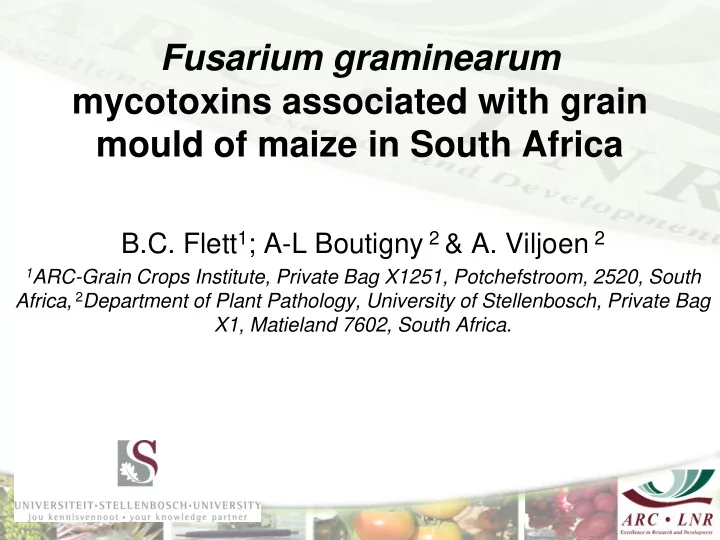

Fusarium graminearum mycotoxins associated with grain mould of maize in South Africa B.C. Flett 1 ; A-L Boutigny 2 & A. Viljoen 2 1 ARC-Grain Crops Institute, Private Bag X1251, Potchefstroom, 2520, South Africa, 2 Department of Plant Pathology, University of Stellenbosch, Private Bag X1, Matieland 7602, South Africa.
Fusarium graminearum mycotoxins associated with grain mould of maize in South Africa Two distinct aspects to this project the first (collaboration with SU) will be presented by Prof Bradley Flett ARC- GCI and the second (collaboration with ARC-PPRI and UFS) by Prof Neal McLaren UFS
SYMPTOMS OF GIBBERELLA EAR ROT
INTRODUCTION • Gibberella ear stalk and root rot of maize ( F. graminearum ) • Recent studies have divided the Fusarium graminearum species complex (FGSC) into a number of species/lineages • Problems increased when rotated with other graminaceous hosts
INTRODUCTION • Produce mycotoxins: DON, NIV and ZEA • DON and NIV – protein synthesis inhibitors and cause anaemia, immunosuppression, haemorrhage, diarrhoea and emesis. • ZEA – non-steroidal estrogenic mycotoxins – estrogenic symptoms • Chemotyping of FGSC isolates
F. ussurianum F. aethiopicum F. graminearum F. gerlachii Complex of 13 species (FGSC) complex F. asiaticum F. vorosii F. acaciae-mearnsii F. boothii F. mesoamericanum F. austroamericanum F. cortaderiae - O’Donnell et al. , 2000 F. brasilicum - Ward et al. , 2002 F. meridionale - O’Donnell et al. , 2004 - Starkey et al. , 2007 - O’Donnell et al. , 2008 - Yli-Mattila et al. , 2009
AIM 1) Determine distribution and co-occurrence of four Fusarium species and their mycotoxins (focus on FGSC) 2) FGSC of GER of maize in South Africa
MATERIALS AND METHODS Distribution and co-occurrence of four Fusarium species and their mycotoxins • Maize samples collected from 2 cultivars from 14 representative localities • Real-time PCR used to quantify grain colonisation by the 4 major Fusarium species • Multi-toxin analysis HPLC-MS was used to quantify mycotoxins
Results: 2008 average 2 cultivars average locations GAUTENG MPUMALANGA NORTH WEST F. verticillioides F. subglutinans F. graminearum F. graminearum F. subglutinans KWAZULU NORTHERN NATAL CAPE FREE STATE F. subglutinans F. verticillioides F. graminearum
2009 average 2 cultivars NORTH WEST average locations GAUTENG MPUMALANGA KWAZULU NORTHERN NATAL CAPE => Infection higher in 2009 FREE STATE => F. graminearum infection shifting F. subglutinans F. verticillioides => Risk in DON and ZEA contamination in F. graminearum maize high!
RESULTS – MYCOTOXINS OF GER Log of the sum of type B trichothecenes and zearalenone and the log of the infection coefficient of F. graminearum was linearly correlated (R 2 = 0.74)
DISCUSSION • In 2008 F. graminearum was the dominant species in the eastern production areas • In 2009 ear rots were higher and similar tendencies were noted but F. graminearum became predominant in the Northwest Province as well • DON and ZEA were well correlated with F. graminearum grain biomass
MATERIALS AND METHODS FGSC of GER of maize in South Africa • 100 isolates of FGSC from GER were collected from various localities throughout the South African maize production area • Multilocus genotyping assay were used to determine FGSC species identity and trichothecene chemotype (Ward et al. , 2008) • One isolate was analysed further using sequence analysis and com-pared to other published sequences
RESULTS FGSC of GER/FHB of maize/wheat in South Africa Host Chemotype N = 15-ADON NIV 3-ADON Wheat 93.1 6.1 0.7 277 Barley 99.3 0 0.7 148 Maize 100 0 0 100 Maize (roots) 86 14 0 35
RESULTS FGSC of GER of maize in South Africa • 99/100 GER isolates were F. boothii which is a 15-ADON chemotype • 1/100 GER isolate was collected in Gauteng and it was found to be a interspecific hybrid between F. boothii and F. graminearum
DISCUSSION FGSC of GER of maize in South Africa • GER in South Africa is caused primarily by F. boothii which being a 15-ADON chemotype indicates that DON is the primary trichothecene • The FGSC of GER differs significantly to that of maize root and crown rot as well as that of FHB of wheat and barley
CONCLUSION • It appears that seasonal variation may affect the primary mycotoxins in maize production areas of South Africa • GER is predominant in eastern production areas and may predominate in the north western production areas in South Africa • The strong correlation between F. graminearum incidence and DON and ZEA indicates that these mycotoxins are a real threat in local maize production
CONCLUSION • The predominance of F. boothii in the FGSC in GER indicates that the predominant trichothecene should be DON. • The difference in the FGSC of GER and FHB counters the thought that wheat and maize rotations increase both diseases • The hybrid isolate shows that there may still be some doubt as to whether the species within the FGSC are sexually incompatible
ACKNOWLEDGEMENTS • Maize Trust and ARC-GCI for funding • Collaborators: Todd Ward and Kerry O’Donnell from USDA Peoria IL, USA • Collaborators: S. Zuhlke and M. Spiteller from Dortmund University of Technology, Dortmund, Germany • Ms Belinda Janse van Rensburg for sample collection
Recommend
More recommend